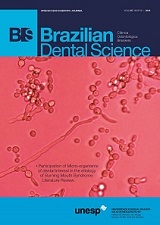Participation of micro-organisms of dental interest in the etiology of Burning Mouth Syndrome: literature review
DOI:
https://doi.org/10.14295/bds.2013.v16i2.864Abstract
The Burning Mouth Syndrome (BMS) is a pathologic entity characterized by the presence of chronic symptoms of burning or pain in normal oral mucosa. It mainly affects women in the postmenopausal period, and its cause is unknown, but as there is an association with biological and psychological factors, it may assume a multifactorial etiology. Considering the unclear etiology of BMS, studies that contribute to its understanding are of great importance. In order to achieve a better understanding regarding microbial etiological factors of this disease, the aim of this review is to compile studies on possible involvement of micro-organisms of dental interest in the etiology of BMS. Studies have reported that patients with BMS harbor greater amount of intra-oral Candida and Enterobacteriaceae than patients without clinical manifestations of this disease.
Different sources such as articles, books and journals, published in the world literature, were used in this research. These sources were accessed by databases like PubMed, SciELO, Scopus or search of full text. Studies in the literature have suggested that Candida and Enterococcus were correlated with BMS, although they might not necessarily be considered as an etiological factor but a predisposing factor. However, further studies that aim to elucidate relation between BMS and infectious factors are necessary.
Keywords
Candida; Enterobacteriaceae; Burning mouth syndrome.
Downloads
Downloads
Published
How to Cite
Issue
Section
License
Brazilian Dental Science uses the Creative Commons (CC-BY 4.0) license, thus preserving the integrity of articles in an open access environment. The journal allows the author to retain publishing rights without restrictions.
=================




























